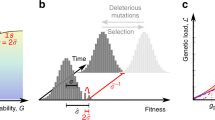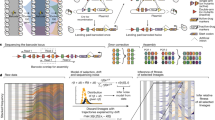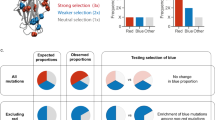Abstract
Clonal selection strategies are central tools in molecular biology. We developed a general strategy to dissect protein functions through positive and negative clonal selection for protein-protein interactions, based on a protein-fragment complementation assay using Saccharomyces cerevisiae cytosine deaminase as a reporter. We applied this method to mutational or chemical disruption of protein-protein interactions in yeast and to dissection of the functions of an allosterically activated transcription factor, Swi6.
This is a preview of subscription content, access via your institution
Access options
Subscribe to this journal
Receive 12 print issues and online access
$259.00 per year
only $21.58 per issue
Buy this article
- Purchase on Springer Link
- Instant access to full article PDF
Prices may be subject to local taxes which are calculated during checkout


Similar content being viewed by others
References
Reguly, T. et al. J. Biol. 5, 11 (2006).
Pelletier, J.N., Campbell-Valois, F.X. & Michnick, S.W. Proc. Natl. Acad. Sci. USA 95, 12141–12146 (1998).
Michnick, S.W., Ear, P.H., Manderson, E.N., Remy, I. & Stefan, E. Nat. Rev. Drug Discov. 6, 569–582 (2007).
Mahan, S.D., Ireton, G.C., Knoeber, C., Stoddard, B.L. & Black, M.E. Protein Eng. Des. Sel. 17, 625–633 (2004).
Hartzog, P.E., Nicholson, B.P. & McCusker, J.H. Yeast 22, 789–798 (2005).
Wei, K. & Huber, B.E. J. Biol. Chem. 271, 3812–3816 (1996).
Fang, F., Hoskins, J. & Butler, J.S. Mol. Cell. Biol. 24, 10766–10776 (2004).
Korkegian, A., Black, M.E., Baker, D. & Stoddard, B.L. Science 308, 857–860 (2005).
Block, C., Janknecht, R., Herrmann, C., Nassar, N. & Wittinghofer, A. Nat. Struct. Biol. 3, 244–251 (1996).
Porter, S.W. & West, A.H. Biochim. Biophys. Acta 1748, 138–145 (2005).
Bahler, J. Annu. Rev. Genet. 39, 69–94 (2005).
Andrews, B.J. & Moore, L.A. Proc. Natl. Acad. Sci. USA 89, 11852–11856 (1992).
Sedgwick, S.G. et al. J. Mol. Biol. 281, 763–775 (1998).
Remy, I., Wilson, I.A. & Michnick, S.W. Science 283, 990–993 (1999).
Tarassov, K. et al. Science 320, 1465–1470 (2008).
Pelletier, J.N., Campbell-Valois, F.X. & Michnick, S.W. Proc. Natl. Acad. Sci. USA 95, 12141–12146 (1998).
Block, C., Janknecht, R., Herrmann, C., Nassar, N. & Wittinghofer, A. Nat. Struct. Biol. 3, 244–251 (1996).
Giaever, G. et al. Nature 418, 387–391 (2002).
Rollins, C.T. et al. Proc. Natl. Acad. Sci. USA 97, 7096–7101 (2000).
Ralser, M., Goehler, H., Wanker, E.E., Lehrach, H. & Krobitsch, S. Biotechniques 39, 165–166, 168 (2005).
Acknowledgements
We thank H. Bussey (McGill University) for providing yeast strains and p41XGal1 plasmids, B. Andrews (Donelly Centre, University of Toronto) for plasmids pBA487 and pBA251 and Swi6 antibodies, T. Clackson and V. Rivera (Ariad) for pC4EN-FM3, M.J. Booth for constructing p415Gal-Linker-OyCD-F[2], and M. Malleshaiah and C. Chan for comments. This research was supported by grants from the Canadian Institutes of Health Research (MOP-152556) and the Canada Research Chairs Program to S.W.M. P.H.E. acknowledges the Faculté des etudes supérieurs de l'Université de Montréal for scholarships.
Author information
Authors and Affiliations
Contributions
P.H.E. and S.W.M. designed the experiments, analyzed the results and wrote the manuscript. P.H.E. performed the experiments.
Corresponding author
Supplementary information
Supplementary Text and Figures
Supplementary Figures 1–9 and Supplementary Tables 1–3 (PDF 4330 kb)
Rights and permissions
About this article
Cite this article
Ear, P., Michnick, S. A general life-death selection strategy for dissecting protein functions. Nat Methods 6, 813–816 (2009). https://doi.org/10.1038/nmeth.1389
Received:
Accepted:
Published:
Issue Date:
DOI: https://doi.org/10.1038/nmeth.1389
This article is cited by
-
Dynamic protein assembly by programmable DNA strand displacement
Nature Chemistry (2018)
-
Protein interaction perturbation profiling at amino-acid resolution
Nature Methods (2017)
-
An infrared reporter to detect spatiotemporal dynamics of protein-protein interactions
Nature Methods (2014)
-
PKA regulatory subunits mediate synergy among conserved G-protein-coupled receptor cascades
Nature Communications (2011)
-
You too can play with an edge
Nature Methods (2009)



